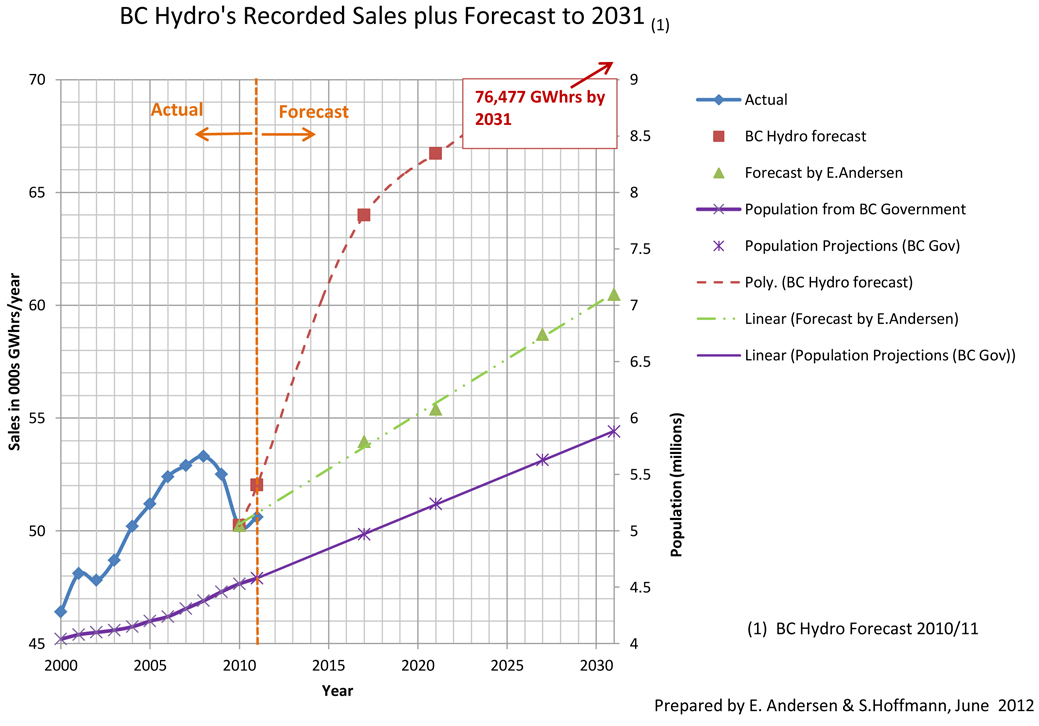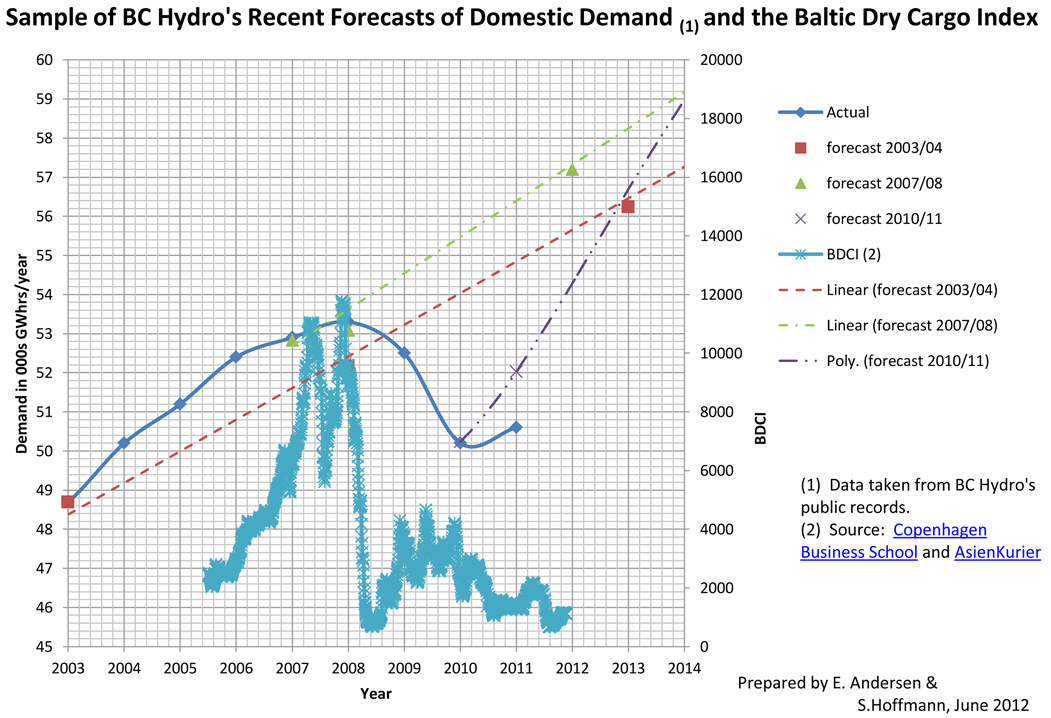I was astonished to read, “A new forecast by BC Hydro shows electricity demand in the province is expected to grow by 50 per cent over the next 20 years,” in a recent article from the Vancouver Sun. To understand why I use the term “astonished”, one must delve deeper to see that this statement is not supported by Hydro’s own data and other global economic data. Rather than taking everything at face value, I’ve learned it’s critically important to question the statements made by BC Hydro and the current provincial government. After watching a documentary on the collapse of Enron and how wild forecasting and lack of genuine oversight led to one of the largest financial failures in modern history, the resounding statement was, “ask why” – wise words to follow to avoid repeating history.
It will be of help to the reader to understand some of the financial implications of BC Hydro’s forecasting. Discussion should start with the understanding of the unit used to measure and report about electrical energy. It is the Gigawatt hour (GWhr) per year, as you can see in the chart that follows. Using the public values associated with the proposed Site C generation plant, it takes $2,000,000 of borrowed money to produce one GWhr/year of usable energy. Keep in mind as you read what follows, your Government and BC Hydro are apparently intent on borrowing and spending, in your name, $30,000,000,000 by 2017. If left to follow the path set out in the most recent BC Hydro forecast, the corporation’s total liabilities will explode to $80,000,000,000! As a shareholder, ratepayer and guarantor of the debt are you ready for this experience?
This is an evidence-based discussion, which means looking at actual domestic demand from BC Hydro’s annual financial reports in concert with various historical demand forecasts by BC Hydro. This data is shown in Graph 1, below.

It can be seen from this graph that the domestic demand had a significant downturn starting in 2008 and that we are currently at pre-2005 levels. Comparing BC Hydro’s forecasts with the actual demand clearly indicates how poorly they match up, even failing to predict any degree of decline.
What is arguably even more striking than BC Hydro’s apparently poor forecasting skills is the trend in their forecasting. According to their predictions, the rate of increase in demand is greater for each forecast, illustrated by a sharper rise for each subsequent forecast. This begs the questions as to why this would be the case and if there is any justification for it.
BC Hydro has previously stated that this increasing domestic demand is based on increasing population. However, population growth, plotted in Graph 2, can be seen to be fairly linear from 2003 onward. With the population increasing at a fairly steady rate, one would similarly expect domestic demand to increase at a constant rate, if modelled on population growth. Added to this is the growing recognition that per capita demand for electricity has been declining since 2008. An increasing rate would result from accelerated population growth, which is not the case. This becomes most troublesome with the 2010/2011 forecast, which portrays a dramatic rise in the forecasted rate of increase without the associated population growth to warrant it. What is the justification? There is none – it is a deliberate exaggeration of provincial demand.

Graph 2 includes BC Hydro’s longer term forecast to 2030. In addition, it shows a projection by Erik Andersen that utilizes a per capita demand value for residential plus commercial customers coupled with an expectation of industrial demand. The latter is reflective of new industrial customers having to pay higher than the “legacy rates” that are available to some established large customers.
By presenting an exaggerated need for more domestic generation capacity BC Hydro is giving cover for its call for new Independent Power Producer contracts and for projects like Site C. This is a continuation of a corporate culture documented in the book White Gold by Karl Froschauer.
What BC Hydro and the current government are ignoring is the present state of the global economy. Of the many global business indicators available one of the best is the Baltic Dry Cargo Index. This historical index combines dry cargo shipping charter rates with volumes. It is considered by professionals as the only uncontaminated global index because it is not subjected to speculative “gaming”. It is also considered one of the best leading economic indicators available to the public. Graph 3, below, adds the Baltic Dry Cargo Index to Graph 1 (above).

It is interesting to note how closely the BDCI matches the trend in domestic BC electricity demand. To ignore the current global economic climate, which domestic demand appears to parallel, is a seriously large financial gamble.
BC Hydro has a well-documented history of exaggerating demand to serve corporate interests and that pattern is repeating. There is no evidence to support their claim and BC citizens need to start asking “why?” to avoid the blunders of the past reoccurring. In terms of the current state of the global economy, there is trouble out there and you don’t go stepping out into new debt at a time like this.
A recent article in the New York Times has shown that Asia has been “falsifying economic statistics to disguise the true depth of the troubles”, which is why a global indicator such as the BDCI is so important. Folks who aren’t making their “numbers” resort to “Enron-style” information flow. China’s sputtering economy is facing tumbling electricity demand, yet that is largely being hidden.
We must insist on evidence-based projections of demand that take into account the global economy as opposed to wishful thinking on BC Hydro’s part. The latter has the tendency to produce stranded assets at the expense of the citizens of BC.
Sandra Hoffmann is a Ph.D chemist specializing in water chemistry and is the former coordinator for the Peace Valley Environment Association. Erik Andersen is an independent economist and regular contributor to the Common Sense Canadian.


I can’t believe that the federal, provincial and municipal governments still use taxpayer dollars to fund corporate growth and nobody says or does anything about it. Democracy is dead and Corporate Rule is the order of the day.
Good work. We very much need good evidence based analysis because B.C. Hydro and our current government are definitely leading us astray and not using our resources properly and putting huge costs unto the backs of the people of B.C. for poor energy policy and our environment is suffering badly. Please spread this information as much as you can. Thank You.
The authors of this article fail to take into consideration the power hungry resource boom that is now beginning to take shape in this province. Many mines and natural gas projects will require huge amounts of electricity to extract and process raw materials.
Hydro rates are going up, that we know. As rates go up, people will use less electricity.
An interesting article from Popular Mechanics states “Once past the half-century mark, dams begin to degenerate: Concrete walls degrade, earthworks erode and seep, spillway gates rust and lose tensile strength, and sediment clogs reservoirs, reducing their capacity.”
http://www.popularmechanics.com/science/environment/water/2294301
It should also be noted that the proposed Site C dam is completely reliant upon the integrity of the upstream WAC Bennett dam which is almost a half-century old and after only 28 years had developed sinkholes that suggested a serious threat of failure at that time. The WAC Bennett dam also has no decommissioning plan. Makes one wonder about the lack of long-term planning.
It should be noted that the proposed Site C is an earthfilled dam. A 100 year lifetime is often predicted, however, there are no case studies yet to see if this is a reasonable assumption. As with most major construction projects, there should be a decommissioning plan, especially since dams are known to have silt accumulation and weaken with age. Silt accumulation would be significant given the soils and sloughing concerns at the proposed location. BC Hydro has not included a decommissioning plan and the cost of such has not been included in their $8 billion projected cost.
John, thanks for bringing maintenance and repair into the discussion.
Some concretes are by design have much longer lives than 100 years. The Syrians and Romans constructed some excellant examples using a mix thatincluded diatoms. I think the Confederation Bridge used the modern day equivalent, silica fume.
Most good business make contious provisions for major maintence and even replacement. Presumably BC Hydro should do likewise since the chosen locations for dams are there for ever.
It should be recalled that most older hydro dams eventually have to be de-commissioned. The strength of concrete starts to deteriorate when it nears 100 years old.
This story is right on the money. We in Tsawwassen had huge power lines pushed through our town and had our rights suspended by the Campbell government. The reason given was that the Island was in desperate need of power. We know that was a lie. It was so private intersts could profit from power sales to the US. That didn’t work when the government of California wouldn’t buy the power because it wasn’t green. In the meantime hundreds of lives were adversely affected, our courts were used to jackboot the residents and millions were spent on court fees, buyout fees, policing and costs that have been hidden. It will now be up to BC Hydro customers to pay for this project that lined the pockets of Liberal friends. The lines are hardly used because the Island didn’t need the power in the first place.
Good work.
This story needs to be plastered on the front of every newspaper and TV in the province.
Let’s not forget our relatively meagre population numbers (4.5m), in relation to these fantastic projections (of debt).
Will the current MSM tell the truth in the face of such compelling evidence? Unlikely.
Will Mr. Dix have first,the opportunity and/or second, the stomach, to squelch this utter stupidity. I remain to be convinced.
Stay tuned…